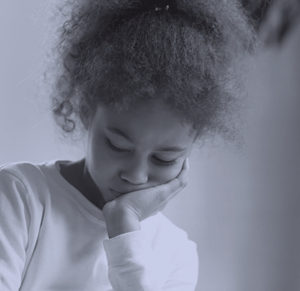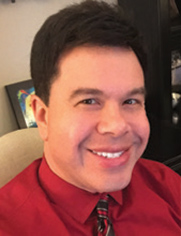Challenges in ADHD Care for Children of Color–Part Two
 Children of color who have ADHD often experience barriers to receiving mental health care. Stigma regarding ADHD persists and prevents many of these children from receiving the supports they need. It is critically important for educators and healthcare professionals to be transcultural when providing care and education. And it is equally important that African-American parents know how to advocate for their children in medical and educational settings.
Children of color who have ADHD often experience barriers to receiving mental health care. Stigma regarding ADHD persists and prevents many of these children from receiving the supports they need. It is critically important for educators and healthcare professionals to be transcultural when providing care and education. And it is equally important that African-American parents know how to advocate for their children in medical and educational settings.
In the second episode of the All Things ADHD conversation on challenges in ADHD care for children of color, clinical psychologist Roberto Olivardia spoke with Melvin Bogard, CHADD’s director of multimedia content. Dr. Olivardia explains the barriers to mental health care in the Black community and offers ways healthcare practitioners and educators can provide services for different cultures. He also provides information for parents on how to advocate for their children and help them face these challenges. The following excerpts from their discussion were edited for length and clarity.
MELVIN BOGARD: How do we help educators to be more transcultural in their thinking and in the classroom?
ROBERTO OLIVARDIA: We definitely have to do a lot more training with educators; also in understanding how school systems deal and work with ADHD or kids with learning disabilities. For example, studies find that African-American children who are diagnosed with ADHD are more likely to be put in a special ed classroom, when they may not need those services of special education. Some do, but ADHD in and of itself doesn’t have to warrant placement in a different classroom. It might warrant accommodations within a classroom—unlike, let’s say, a child with dyslexia who may need a different classroom, a different level of instruction. If the kids with ADHD are just grouped with kids that might be on the autism spectrum or have dyslexia or other issues, the kids with ADHD are not getting what they need in that way.
We want to look at it from the institutional perspective, asking schools, What is your process of identifying ADHD? Teachers are in an amazing role; they’re often the first people parents hear saying, “You know, I’m noticing something in your child.” Teachers can’t diagnose, but they can say it warrants some further exploration or examination. Keep in mind that certain school systems might have very poor resources, or have a threshold of behavior that might make it difficult to detect the child who has ADHD but behaves very well, who’s under the radar because there are a lot of children acting out in more externalized ways.
When a child is acting out it’s easy for parents to notice them. It’s harder to recognize girls with ADHD, which is why African-American girls with ADHD often are the least identified in these cohorts, because girls with ADHD often are more internalized with their behavior. They’re more quiet, their self-esteem is low, they’re more depressed. They don’t act it out in the same way.
We still have a way to go in educating teachers about ADHD and communities of color, understanding how that diagnosis might land on families, understanding their view and philosophy, and speaking about the benefits of diagnosis and treatment. We need to convey that this is not an indictment on your parenting, that this is not a weakness at all in that way. I think that’s where the messaging gets lost.
I’ve heard from people of color who have said, just in general about depression or other issues, “We don’t really talk about those in our circles. We think those are white people problems.” There is a stigma that’s much bigger in communities of color. Also, understanding that ADHD is heritable, and so a lot of these kids with ADHD have parents with ADHD that may or may not have been managed. When you’re working with any parent, you need to understand that you could be unearthing their own past traumas of being in school and being labeled bad, and thinking, “Oh, I don’t want that for my child.”
We use terms—defensiveness, suspiciousness, distrust—and these terms unfortunately have this pejorative sense that we put on the parent, as opposed to saying, “Well, wait a minute. Maybe there’s a reason that these parents feel this way. Maybe it’s warranted, not only individually but just culturally and historically why that is.” That’s where we need to train educators and individuals. Because teachers really are amazing individuals. They have such a hard job. It’s not pointing fingers or blaming them. It’s more, again, understanding that all of us carry our own implicit biases in that way.
Many Black people struggle to talk about mental health issues. How do we start the conversation?
I think it’s really reaching people where they are at: talking in their church about mental health and bringing that into the church community, boys’ and girls’ clubs, afterschool programs. It certainly helps when there’s the visibility of successful African-American individuals who have ADHD. Also helpful are podcasts like this and talks at ADHD conferences that are geared toward people of color and bringing them together.
I remember at a CHADD conference some years back—they have these sort of networking groups, typically in the evenings—I facilitated one on people of color. There were a lot of moms and dads, African American and Hispanic, in the room. It was the first time that many of them had even met a fellow parent of color to talk about this. Just to reach out and have somebody else reach out and speak of that experience, and those special concerns, is powerful—really, really powerful.
 Parents need to be more proactive as well, but what role do they play in the success of their child and advocating for fairness?
Parents need to be more proactive as well, but what role do they play in the success of their child and advocating for fairness?
For parents, a lot of it is getting the education about ADHD and understanding that it’s okay to ask for help. That it doesn’t mean that they have failed, that they are weak, or that they are bad parents in any way. One of the other concerns I hear from these parents is that they fear how an ADHD diagnosis will follow their child. They ask, Is this something that’s going to follow my child, that will cut off their opportunities if they want to go into the military, or in a future job? It is important to emphasize to the parents how proper treatment is going to be better for their child.
With all the tragedy that happened with COVID, the upside is that therapy services have gone remote and virtual, and studies show that they can be just as effective. Now, that has really opened up something very exciting for communities of color, particularly for those for whom it has been difficult to find transportation and time to get to a counselor.
I tell parents, “Engage with your child, and let your child know that they’re not defective, their brain is not wrong.” A lot of the time parents are hesitant, because they don’t want their child to feel different. And I tell them, “Well, they are different and they feel different. Different doesn’t have to be bad. Different doesn’t have to be defective.” A parent may worry about a label, but for the child, knowing they have ADHD often helps them to understand, “Oh, okay. There’s something that explains this. It’s not that I’m dumb. It’s not that I’m weak.” Those are the terms that they’re going to think of for themselves unless they get a frame that helps them understand what the issue is.
What would a more culturally sensitive diagnostic tool look like?
That’s a great question. This is where, even when we take it from the assessment level, we need to really reexamine all of our diagnostic tools and ask, Is this culturally competent in terms of the questions that we’re asking and how we’re understanding? This can lead again to both underdiagnosis and overdiagnosis, because if you say, “Are there times of the day that you’re distracted and inattentive?”–well, we also know that that could be due to anxiety, to growing up in an abusive family, or because the they’re hungry. That could be because the child didn’t sleep well because there’s no heat in their house. There are lots of things. I would say at the very basic level, we never want to just look at a piece of paper, a survey, a test, and say, “Okay, this person has or doesn’t have it.” It’s taking that and really connecting to the story of that individual.
At the end of the day, if a
child is not succeeding in school,
then there’s something happening.
Even if the test scores show X, Y and Z,
we’re not getting to the heart of the matter.
One of the things that communities of color often value is the art of the narrative, the art of storytelling, and really understanding somebody in a specific context. As clinicians, as people who assess, it’s to just have somebody talk and say, “Tell me what your concerns are, and share with me.” If it’s a parent talking about their child, “Tell me who your child is. What are your concerns?” And letting them know that boxes that get checked are supplemental, we don’t want that to determine [the diagnosis]. At the end of the day, if a child is not succeeding in school, then there’s something happening. Even if the test scores show X, Y and Z, we’re not getting to the heart of the matter. We want to look at all of the issues that are involved.
At the very basic level, we need more research that specifically focuses on people of color and that evaluates these instruments. We might find that some of these instruments are culturally competent, but we don’t 100% know until we’ve normed it and have reference groups that are primarily people of color. There are individuals of color, and then there are also different socioeconomic groups, whether they’re people of color or not; that’s another variable of intersectionality that’s really important.
Studies still show that even African Americans in higher socioeconomic groups struggle with proper assessment, proper diagnosis, proper treatment, and stigma. Of course, they’re still subject to racism and discrimination. If you are of a lower socioeconomic group and a person of color, there’s a lot there that we have to understand; there’s an exponential effect when you have these variables. That’s why we see that for African-American girls who are growing up in lower socioeconomic [groups], there are tremendous barriers to proper identification.
How do we get more healthcare professionals invested in treating all people fairly?
With education, and I think it starts very early. I feel fortunate in that I got my PhD at the University of Massachusetts in Boston, and this program was way ahead of its time. It’s very focused on cross-cultural psychology, cultural competence—when I was in graduate school, in every course we had from assessment to psychopathology. We also had our own cultural mental health course. But embedded in every course we looked at, okay, so this is how we learn about it; however, let’s look at the research. We’d find that this was normed with white men—and what does this mean for women? What does this mean for LGBTQ? What does this mean for African Americans? We need more of that model in graduate school programs for psychologists, social work programs, and medical schools. I am seeing more of that in terms of diversity training and understanding.
When you have a patient who comes through the door, [a doctor needs to be] understanding their story and understanding the context of those symptoms. So, for example—and this was just a casual conversation I had with a physician at a conference a couple years ago who said, “Yeah, sometimes I see patients, and by the time they come to see me their diabetes is so out of control. Come on, you need to come from when this problem is starting”—placing this sort of implicit or explicit blame on the patient. Like, “Oh, you came way too late.”
Let’s understand what might’ve gotten in the way. Maybe that person has copays that they can’t afford. Maybe they’re working two or three jobs and they don’t have time. Maybe they’re raising their children and they’re thinking, “You know what, if I have to pay for medical services, it’ll be for my children, not for me.” Maybe they can’t afford healthy food. And so, unfortunately, the food that they can afford is going to be food that’s high in fat and that isn’t going to be good for their health. All of that. So, as opposed to understanding, “Okay, so tell me that, and now I can understand that.”
Even though this doctor was a good person who wanted to treat their patient, if we understand that if there’s any sense of judgment—even implicitly—that comes through without understanding the context, that patient feels shamed. They feel distrustful. They feel, “Well, how do I expect to put myself in this person’s care?”
Again, there’s blatant full-out racism, but even more so, we see these kinds of implicit biases and a lack of really understanding the full context. That’s where we in the medical and mental health professional world need to continue to step up and train as we’re training individuals to do that. And then [we need to] have continuing education around that.
I’m in Massachusetts, and in Massachusetts, every two years we have to renew our license as psychologists. It was mandatory that we had this cultural course in terms of looking for continuing education, as well as other courses. I think that has to be a requirement, making it important for people to look at. Even people who are very politically aware, very socially aware, who think they understand. You understand about racism, certainly. You may not be racist, absolutely. However, do you understand fully? And so that’s what we have to do in terms of educating people.
I would implore anyone to do a Google search for African Americans and ADHD, people of color and ADHD, and find resources online. Read articles, hear the voices of people who have experienced it and have experienced some of the barriers. Thank you for covering this topic and getting people in the ADHD community talking about it.
End of Part Two
Part One of Challenges in ADHD Care for Children of Color


 Roberto Olivardia, PhD, is a clinical psychologist and lecturer in the department of psychiatry at Harvard Medical School. He maintains a private psychotherapy practice in Lexington, Massachusetts, where he specializes in the treatment of ADHD, executive functioning issues, and students with learning differences. He also specializes in the treatment of body dysmorphic disorder, obsessive-compulsive disorder, and eating disorders in boys and men. He currently serves on the professional advisory boards for CHADD, ADDA, and the National Association for Males with Eating Disorders.
Roberto Olivardia, PhD, is a clinical psychologist and lecturer in the department of psychiatry at Harvard Medical School. He maintains a private psychotherapy practice in Lexington, Massachusetts, where he specializes in the treatment of ADHD, executive functioning issues, and students with learning differences. He also specializes in the treatment of body dysmorphic disorder, obsessive-compulsive disorder, and eating disorders in boys and men. He currently serves on the professional advisory boards for CHADD, ADDA, and the National Association for Males with Eating Disorders.